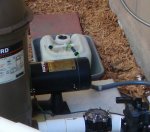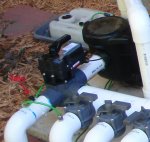I just wanted to update on my system as I think I've finally gotten all the bugs worked out and have made it as simple as possible. Its been working perfectly for about 5-6 months now.
A big thanks to Mark (mas985) for starting this thread and sharing his invention with us. I basically copied him except I had the problem of the acid siphoning into the pool when the pump was off. To fix that I had to put my tank at the same level as the pool. I dug a small hole near the equipment pad and put a plastic container in the hole, then put my acid tank in the container. That way I could still see the level in the tank.
I drilled two holes in the acid tank. One for the vent which I pushed in an irrigation dripper just to keep debris out. The other hole is for the feed hose. I cut the end of the hose at an angle and pushed it into the tank leaving it off the bottom by about 1/2" so it does not suck up any debris that gets in the tank.
I have a plastic rubber bladder type check valve bought from a pet store used for aquarium pumps in the feed line. The check valves with metal springs won't last, so it has to be the all plastic / rubber type. This keeps water from going into the tank. I also have an irrigation dripper in line. Don't remember the gpm, but I tried various combinations and found just this single one works the best.
I went through lots of valves that I had laying around the garage. In the end, I found the 15 cent dripper irrigation shut off valve worked best.
I tapped into the suction side of the main pool drain line. By doing it this way, I don't need a systolic pump and I'm not injecting acid when only using the spa.
To regulate the acid into the pool I can use a combination of ratio levels of acid to water in the feed tank and/or make small adjustments to the shut off valve. As the pool has aged, the acid demand has dropped and is pretty consistant now. I now only add acid and water into the feed tank about every 2 weeks.[attachment=1:1j5xrm5a]P1023911.jpg[/attachment:1j5xrm5a][attachment=0:1j5xrm5a]P1023910.jpg[/attachment:1j5xrm5a]



